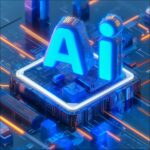Artificial Intelligence And IP (Part I)
As AI improves to the point where it can create art works or write newspaper articles, a number of intellectual property questions arise.
 There have been a number of events recently on artificial intelligence (AI), covering the roles of different institutions, highlighting various projects, and discussing various legal issues related to AI. There are so many interesting dimensions to AI and machine learning, from the privacy and ethical concerns, the dilemmas regarding biased algorithms, and of course, intellectual property. Today, I offer some half-baked thoughts on AI and copyright.
There have been a number of events recently on artificial intelligence (AI), covering the roles of different institutions, highlighting various projects, and discussing various legal issues related to AI. There are so many interesting dimensions to AI and machine learning, from the privacy and ethical concerns, the dilemmas regarding biased algorithms, and of course, intellectual property. Today, I offer some half-baked thoughts on AI and copyright.
AI today is pretty incredible and prevalent in everyday interactions, from using Apple’s Siri as a personal assistant to interacting with Amazon’s Alexa at home to using chatbots on social media. As better algorithms are developed, broader data sets are provided for training, these systems continue to learn, and we have improved outputs. In 2016, for example, “The Next Rembrandt” project produced an impressive “new Rembrandt” painting more than 400 years after the master artist died. While the creators of the project acknowledge that the computer-created Rembrandt wouldn’t fool an art expert, it is still a remarkable display of machine-learning and output. As AI improves to the point where it can create art works, write newspaper articles, create new songs, or produce full-length movie scripts and novels, a number of intellectual property questions arise.
The first (and obvious) question in the copyright space is: who owns the copyright for these works? Does the person who created the software that produced the painting or novel own the copyright? Does the person controlling the computer program own the copyright in the final output? Does the robot that produced the actual product? Is the item in the public domain?

Diving Into Generative AI: A Practical Guide For Law Firms Starting From Scratch
The U.S. Copyright Office has offered its opinion on the issue, in part responding to the litigation over ownership of the “monkey selfie” (in which PETA filed a lawsuit on behalf of the monkey who took the selfie for copyright ownership; the district court dismissed based on the monkey’s lack of standing under the Copyright Act, and the Ninth Circuit affirmed). While litigation was pending in the case, the Copyright Office declared that under the Copyright Act, human authorship is required; an animal or machine does not qualify. Specifically, the Copyright Office’s compendium notes that it “will not register works produced by a machine or mere mechanical process that operates randomly or automatically without any creative input or intervention from a human author,” which leaves open the possibility of some AI system-created works that require “intervention” from a human could be copyrighted. (NB: AI does not yet exist that allows for 100 percent machine-created works free from all human intervention.) The Copyright Office is suggesting amending this section of the compendium to read, that it will not “register a claim in a work that is created through the operation of a machine or process without sufficient human interaction, even if the design is randomly generated,” expanding the scope of what it considers to be a machine-created work.
This position supports the notion of romantic authorship, emphasizing that authorship relies on original expression and creative decision-making. While the threshold for originality is low, the romantic authorship concept still depends on the idea that creativity stems from humanity. It is rooted in the idea that the human identity is unique because of the ability to think creatively and therefore create original expression. A machine simply following an algorithm or making random decisions does not fulfill this concept. Furthermore, an AI-based program does not need any incentives to create.
But what about the AI-created works that also rely on human intervention? Some have suggested that the person controlling the AI should own copyright in the output. Is it a “work made for hire” under copyright law? An AI-created work doesn’t seem to fall within the current definition; an AI machine doesn’t have personhood and is not an “employee.” Nor can the AI machine “expressly agree in a written instrument signed by them” that it’s a work made for hire, even if it falls within the type of work that can be considered a work for hire. The UK provides that a person controlling computer-generated works is authorship, but U.S. copyright law does not have an analogous provision. As noted above, the Copyright Office’s position remains open on this issue. A number of considerations need to be taken into account, including the fact that with AI-created works — even involving human intervention — could result in numerous independently created but identical or substantially similar works. Demonstrating independent creation is a necessary defense to copyright law — after all, there’s nothing new under the sun. If copyright ownership is granted to the person controlling the AI, how will copyright law handle independent creation of identical or substantially similar works that rely on AI?
Others have argued that the creator of the software behind the AI system should be granted copyright. While the software developer certainly deserves protection for his creation in the software itself, should he be able to also claim authorship of the outputs of the AI system? The software developer already owns copyright in the software itself, but someone else may be inputting other information to create the output. The software developer has already been granted one monopoly in this chain of AI developed work, it may not make sense to grant further monopolies on the products later created that rely on the software.
Sponsored

Diving Into Generative AI: A Practical Guide For Law Firms Starting From Scratch

Gain An Instant Understanding Of New Complaints With LexisNexis Snapshot

Legal AI Tools And Assistants Essential For Legal Teams


Law Firms Now Have A Choice In Their Document Comparison Software
And we have a third opinion offered that AI-generated works belong in the public domain because of the heavy reliance on computer systems to generate these works. While underlying works created by humans would retain copyright protection, the newly created works developed primarily by AI could be considered to have no authorship, and therefore no copyright. The extent to which human intervention is used is likely to play a role in determining whether any authorship can exist.
Remember also that the constitutional rationale for the IP system is to promote the progress of science and the useful arts. Does a person controlling AI to create a literary or artistic work need the incentive of a life of the author plus 70 years, particularly a system that could rapidly create new works? Does the software developer who already is granted a lifetime plus 70 year monopoly need additional incentives to actually run the AI system that has been developed? Would the grant of copyright over AI created works hinder rather than promote the creation of new works and access to these works? Would placing the works in the public domain harm authorship of other works? We’ve already noted that a machine itself requires no incentive and the constitution provides that creative works should be rewarded, but the ultimate goal is to benefit the public.
Even apart from the question of authorship, there are several other questions relating to AI and copyright.
For example, are the datasets used to train AI systems copyrightable? While factual data itself is not copyrightable, compilations of data may be copyrighted if the selection and arrangement are sufficient to meet the originality standard.
And what about the use of training sets relying on copyrighted works? For example, an AI system being trained to write a novel might rely on the ingest of thousands upon thousands of copyrighted novels to learn about human expression. Gaining permissions for the number of works needed to produce a good training set would be impossible, assuming the system wanted to use in-copyright works. Would the use of copyrighted works in these training sets be considered a fair use? Courts have already held that ingesting copyrighted works to create searchable databases, including ones used for text and data mining, is a transformative fair use — for example in the Google Books case, as well as numerous other cases involving databases. This “reading” by AI would not be viewed by humans, and instead is used for the internal learning of a robot. Another consideration, grounded in ethical issues: disallowing fair use in the creation of training sets could result in algorithmic biases that many are trying to correct; AI is only as good as the training sets it learns from. Limiting the works used in the training could result in perpetuating significant biases.
Sponsored

From AI To KPI: The Law Department Tech Trends Of 2024

Law Firms Now Have A Choice In Their Document Comparison Software
While there are so many interesting copyright dimensions to AI and machine learning, other forms of IP and their relationship to AI must also be considered. Stay tuned for more IP-related ramblings, likely to result in more questions than answers.
Krista L. Cox is a policy attorney who has spent her career working for non-profit organizations and associations. She has expertise in copyright, patent, and intellectual property enforcement law, as well as international trade. She currently works for a non-profit member association advocating for balanced copyright. You can reach her at kristay@gmail.com.







